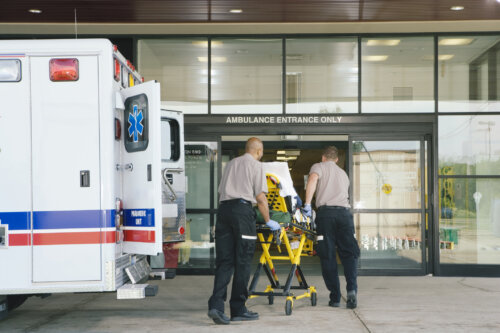
Spinal Cord Injury Lawyers in Seattle Since 1945
Spinal cord injuries are catastrophic, devastating, and life-altering. They can result in paralysis — quadriplegia or tetraplegia and paraplegia. Lifetime medical and caregiving costs for people who have suffered spinal cord injuries are very high.
Spinal cord injury cases are some of the most serious cases we handle. The Stritmatter Firm’s experienced spinal cord injury lawyers have handled spinal cord injury cases in Seattle, Tacoma, and throughout the State of Washington.
Spinal Cord Injuries Are Commonly Caused by:
- Bike, Car, Truck, Or Motorcycle Accidents
- Unsafe Highways And Roads
- Slips And Falls
- Recreational And Sports Accidents Like Diving, Football, And Horseback Riding
- Medical Malpractice
- Dangerous Premises Like Construction Sites
- Violence And Gunshot Wounds

Notable Spinal Cord Injury Case Results
The attorneys at The Stritmatter Firm have wide-ranging experience with spinal cord injuries and understand the complex medical and legal issues involved in these cases. Our knowledge and reputation in litigating spinal cord injury cases have achieved a number of seven and eight-figure settlements for victims of spinal cord injury
- $28,000,000 settlement in Seward v. State of Washington for a young woman who suffered a disabling spinal cord injury when the car she was riding in crashed into an overpass pillar on I-5 that should have been shielded with a guardrail or Jersey barrier.
- $4,000,000 settlement in Remme vs. Seattle, a biker who was thrown from his bike due to an unsafe sidewalk on the Montlake Bridge
- $8,000,000 settlement in Gendler vs State, a bicyclist who was thrown from his bike when the tire became lodged in a gap between metal grates on the Montlake Bridge
- $7,000,000 Settlement in Perez vs THC Construction, a construction worker who was paralyzed as a result of a fall at a job site
The Spinal Cord Injury Attorneys at the Stritmatter Firm Are Here to Help
If you have experienced a spinal cord injury, our attorneys want to help you. Explore more of our case studies below, or schedule your free case evaluation today.

Types of Spinal Cord Injuries
The effects of spinal cord injuries vary according to the type and level of injury. Spinal cord injuries are organized into two categories: incomplete spinal cord injuries and complete spinal cord injuries.
- Complete spinal cord injuries: A person is classified as having a complete spinal cord injury when there is no motor or sensory function preserved in the sacral segments, S4-S5. Any function below the neurological level is lost.
- Incomplete spinal cord injuries: A person with an incomplete injury retains some sensation or movement below the level of the injury. If a person is able to contract the anal sphincter voluntarily or is able to feel a peri-anal pinprick or touch, both of which test the lowest spinal segment, the injury is said to be incomplete.
Location of Spinal Cord Injuries
Spinal cord injuries can occur in the cervical spine, thoracic spine, lumbar spine (L1 – L5), or sacral area.
- Cervical Spine Injuries: Injuries to the cervical spine (the spinal cord in the neck) often result in full or partial tetraplegia (quadriplegia). Depending on the location of the injury, a person suffering from a cervical injury may retain some limited use of the hands or arms or may be completely paralyzed.
- Thoracic Spine Injuries: Injuries to the spinal cord at the level of the chest or below often result in paraplegia, in which case the hands, arms, head, and breathing are usually not affected.
- Lumbar Spine and Sacral Injuries: Injuries to the lower regions of the spine result in decreased control of the legs and hips and impaired sexual, bowel, and bladder function.
Levels of Spinal Cord Injury
There are four levels of spinal cord injury:
- A indicates a “complete” spinal cord injury where no motor or sensory function is preserved in the lower, sacral segments S4-5.
- B indicates an incomplete spinal cord injury where sensory, but not motor function, is preserved below the neurological level and includes the sacral segments S4-5. This is typically a transient phase.
- C indicates an incomplete spinal cord injury where motor function is preserved below the neurological level and more than half of key muscles below the neurological level have a muscle grade of less than 3.
- D indicates an incomplete spinal cord injury where motor function is preserved below the neurological level and at least half of the key muscles below the neurological level have a muscle grade of 3 or more.
Source: The American Spinal Injury Association and the International Spinal Cord Injury Classification System.
Resources for Spinal Cord Injuries
Spinal cord injuries are life-altering. Treatment includes physicians specializing in physical medicine and rehabilitation, as well as mental health treatment for the psychological and emotional trauma that often occurs with a disabling injury. Victims of spinal cord injuries will need to modify their homes to allow for wheelchair access. They may need vans that have been modified for wheelchair access and may need vehicles to be adapted for hand controls to be able to drive independently. They need specialized medical equipment.
There are a number of resources that provide education, medical care, and services to people who have suffered spinal cord injuries. A good place to start is the University of Washington’s Northwest Regional Spinal Cord Injury System.
Impact of Spinal Cord Injuries
Spinal cord injuries cause a host of complications in addition to loss of sensation and motor function below the level of injury, including:
- Impairment of bowel and bladder function. Because bowel and bladder function is controlled by the sacral region of the spine, it is common to experience dysfunction of the bowel and bladder, including susceptibility to infections of the bladder and incontinence.
- Sexual function is also associated with the sacral region and is often affected.
- Breathing control. A loss of breathing capabilities requiring ventilators or phrenic nerve pacing are attributable to spinal cord injuries at C-1 and C-2. Spinal cord injuries at other levels of the cervical spine may require the use of vests to assist with coughing and clearing the lungs.
- Regulatory functions in the body. Because the spinal cord is responsible for regulatory functions in the body, victims of spinal cord injuries may experience the inability to regulate heart rate, blood pressure, and body temperature.
- Spasticity is caused by increased reflexes and stiffness of the limbs.
- Neuropathic pain, which is caused by damage or dysfunction of the nervous system.
- Autonomic dysreflexia, which is a reaction of the autonomic nervous system to overstimulation.
- Muscle atrophy.
- Osteoporosis and bone degeneration.
- Superior Mesenteric Artery Syndrome, an obstruction of the duodenum.
"*" indicates required fields
